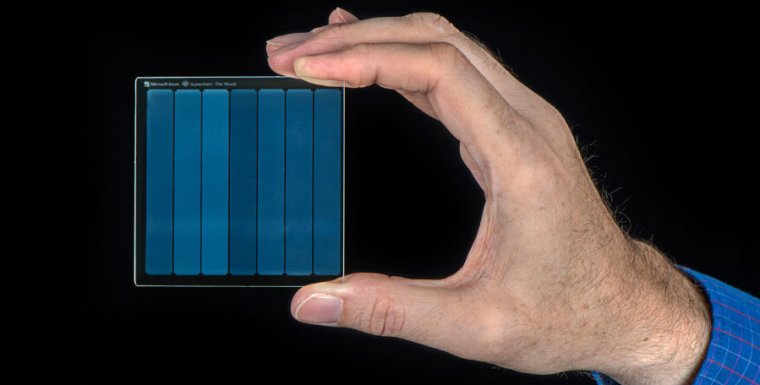
Jonathan Banks / Microsoft
Ars spoke Tuesday with Dr. Ant Rowstron, a principal researcher at Microsoft Analysis in Cambridge, UK, about an revolutionary chilly storage mission referred to as Silica. Silica goals to switch each tape and optical archival discs because the media of selection for large-scale, (very) lengthy length chilly storage. Microsoft Analysis is partnering with movie big Warner Bros., which is instantly serious about decreasing prices and rising reliability in its personal chilly storage applications.
The medium in query is a block of high-purity glass, which has voxels etched into it with femtosecond lasers. Every voxel shops a number of bits in two properties, retardance and angle, which can in flip be learn utilizing microscope imaging and polarized mild. Voxels could also be written 100 or extra layers deep in a 2mm-deep piece of glass, by focusing the laser to the specified depth inside the block itself.
The pace of each reads and writes to Silica at the moment depart one thing to be desired—it took roughly every week to etch Superman's roughly 76GB of information final yr, and Rowstron estimates it might take about three days to re-read the information, with advances made since. The expertise remains to be in its infancy, in fact, and enormous decreases in time required for each writing and studying are anticipated shifting ahead. Rowstron says he nonetheless does not count on anybody is prone to attempt to really play Superman instantly from its Silica document—however that is not what it is meant for.
True long-term archival of information is a really costly proposition. Once I was in school, I took half in a analysis mission for my college's archival division—the division wanted a database utility to index and observe its digital media collections, largely in order that it might have the ability to finances for and perform archive renewal operations inside anticipated refresh cycles. Its older analog audio and video tape recordings wanted to be digitized, and its optical CD and DVD recordings wanted to be learn, checked for integrity, and burned onto new media earlier than the unique discs delaminated.
This archival refresh cycle quickly turns into daunting at any vital scale. Should you assume a set of 10,000 CDs and a staff of three or 4 undergrads with CD-RW drives and an enormous stack of discs, you are greater than a yr of full-time work to refresh them. (Warner Bros., which has a quite greater finances than the uncommon collections division at my alma mater's library, migrates its personal digital archival knowledge on a strict three-year cycle.)
Making issues worse, the lifespan of burned CDs is ceaselessly very brief—they'll simply start failing after solely 5 years, so they need to on the very least be examined that usually, if not refreshed "whether or not they want it or not." It's potential to increase optical discs' lifetime considerably by storing them at 5C/41F and 30% relative humidity, however this provides a major additional expense to storage and upkeep.
That is the issue Undertaking Silica is poised to unravel. Though it is at the moment pretty sluggish to learn or write, Silica's medium—no kind of than high-purity glass—shares none of tape, optical disc, and even paper's failure modes. A Undertaking Silica glass block isn't a compound medium; there isn't any plastic outer overlaying to put on off as there's with CD, DVD or Blu-Ray, and there isn't any magnetic medium to bodily lose from the floor of a tape or laborious disk.
Silica is predicted to outlive for 1000's of years in almost any temperature, humidity, and chemical atmosphere—it is actually simply glass, and the bodily and chemical properties of glass are extraordinarily properly understood. We are able to solely guess on the properties of extra advanced manufactured supplies (tape, disk, and so forth) utilizing accelerated getting older strategies, however glass artifacts 1000's of years previous are available for research.
That is the center of Undertaking Silica—the laser and lensing tools that burns the information into the medium. Microsoft scientist James Clegg is seen right here loading a glass sheet into the machine.
Jonathan Banks / Microsoft
Generally, "science" can imply "boiling your knowledge alive." The staff has baked, boiled, microwaved, degaussed, and scoured its glass with metal wool with out dropping the information saved inside.
Jonathan Banks / Microsoft
This cone beaker, a part of the Cornell Museum of Glass's assortment, dates to roughly 400-600 CE. Sadly, the Anglo-Saxons weren't a lot into lasers then.
Along with the medium's already-impressive resistance to degradation—it could actually mainly be anticipated to shrug off something wanting hitting it with a hammer—the mission makes use of an actual filesystem with Forward Error Correction to additional insure saved knowledge in opposition to corruption or loss. As well as, metadata corresponding to title, index, date, et cetera might be etched into the floor of every Undertaking Silica block in human-readable textual content.
As followers of The Mote in God's Eye already know, one remaining query should be answered for any knowledge storage technique anticipated to final for millennia—what occurs when the technological and cultural context surrounding a storage medium collapses? Silica addresses this downside additionally, through the use of preliminary "floor fact" tracks. The staff is utilizing machine studying algorithms to re-read Silica's knowledge, and within the occasion of the lack of these skilled algorithms, recent algorithms can practice very quickly on the "floor fact" tracks, which educate them how you can interpret the remainder of the information.
We could not resist quizzing Dr. Rowstron on how Niven and Pournelle's Moties might need coped with Undertaking Silica after certainly one of their cyclical collapses of civilization. Even with out machine-learning strategies, researchers who found knowledge saved utilizing Undertaking Silica's strategies ought to have the ability to work out how you can learn its knowledge armed with nothing greater than good microscopes and sources of polarized mild, following the identical path of discovery alongside the "floor fact" tracks that synthetic neural networks would.
